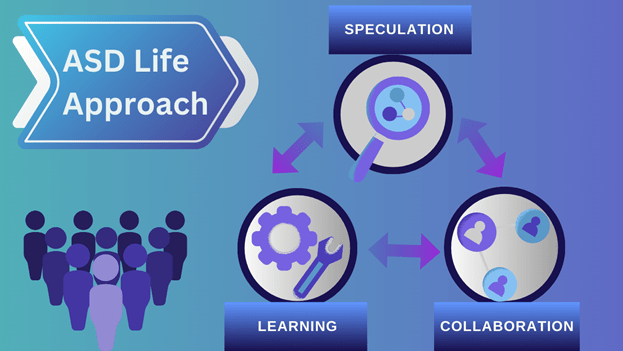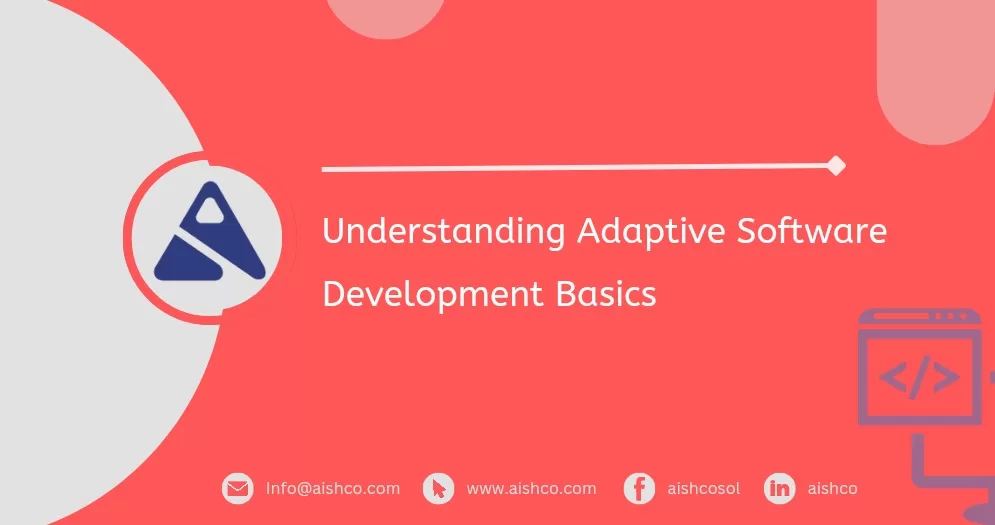Company
Contact
5900 Balcones Drive
#22258 Austin, TX, USA
Subscribe
Follow our newsletter to stay updated about us.
2025-Aishco Solutions & Consultancy. All Rights Reserved.
Share post on
Designed to handle uncertainty and change.
Continuous feedback and improvement loops.
Strong emphasis on teamwork and stakeholder involvement.
A culture of constant reflection, testing, and learning.
ASD was formulated to address limitations in existing methodologies such as Waterfall.
As part of the Agile movement, ASD has gained traction among companies needing to respond rapidly to change.
| Use Case | Examples |
|---|---|
| Web Applications | Facebook, Instagram |
| Single-Page Applications | Trello, Airbnb |
| E-Commerce Platforms | Shopify, Walmart |

The initial phase involves setting broad goals and objectives while remaining open to change.
The second phase involves fostering close collaboration among all team members and stakeholders.
The final phase is dedicated to reflecting on what has been learned and applying these lessons to future iterations.
The table below compares ASD with other agile methodologies such as Waterfall, Scrum, and Kanban, highlighting the key differences in approach, planning, customer involvement, and team collaboration.
| Aspect | ASD | Waterfall | Scrum | Kanban |
|---|---|---|---|---|
| Approach | Adaptive, iterative, and flexible model. | Sequential and fixed model. | Iterative and incremental model. | Continuous, flow-based model. |
| Planning | Adaptive planning, ongoing adjustments. | Comprehensive upfront planning. | Sprint-based planning. | Continuous planning based on work-in-progress. |
| Customer Involvement | High involvement throughout the project. | Involvement mainly at the beginning and end. | Continuous involvement, particularly during sprints. | High involvement with frequent feedback. |
| Team Collaboration | Strong focus on collaboration and communication. | Limited collaboration due to a linear process. | Emphasizes team collaboration in each sprint. | Strong focus on team collaboration and self-management. |
| Risk Management | Proactive and ongoing risk assessment. | Risks managed primarily at the planning phase. | Regular risk reviews in retrospectives. | Risks managed continuously, adapting to real-time changes. |
| Best Suited For | Complex, dynamic, and evolving projects. | Projects with well-defined and stable requirements. | Projects needing rapid delivery and adaptability. | Projects requiring continuous delivery and improvement. |
ASD allows teams to adjust to new requirements or market changes quickly. This flexibility helps in dealing with uncertainty and reducing risks associated with rigid planning.
With its iterative cycles and continuous feedback loops, ASD enables faster delivery of functional software, allowing teams to bring products to market more quickly.
By involving customers in the development process and continuously adapting to their feedback, ASD ensures that the final product aligns more closely with their needs and expectations.
The focus on learning and iterative improvement leads to fewer defects, better performance, and a more polished final product.
To successfully implement ASD, consider the following strategies:
| Aspect | Traditional Methods (e.g., Waterfall, V-Model) | Adaptive Software Development (ASD) |
|---|---|---|
| Development Approach | Linear and phase-based; sequential development. | Iterative and incremental; constant evolution and adaptation. |
| Flexibility | Low flexibility; changes are challenging and costly. | High flexibility; changes are integrated continuously. |
| Planning | Extensive upfront planning with little room for adjustment. | Adaptive planning; continuous feedback and iteration. |
| Customer Collaboration | Limited to early or late stages of the project. | Ongoing collaboration with continuous customer feedback. |
| Risk Management | Focused at the initial stages and monitored occasionally. | Dynamic risk management; continuous assessment and adaptation. |
| Delivery Timeframe | Longer delivery cycles; single release at the end. | Shorter delivery cycles; frequent releases and updates. |
| Quality Assurance | Emphasizes heavy documentation and testing towards the end. | Continuous testing and quality checks throughout the process. |
| Team Structure | Hierarchical and structured. | Cross-functional, collaborative, and empowered. |
| Adaptability | Low adaptability to changes in requirements. | High adaptability; welcomes and integrates change regularly. |
| Customer Satisfaction | Often lower due to delayed delivery and limited engagement. | Higher due to regular delivery and ongoing customer engagement. |
| Risk of Scope Creep | High, due to inflexible change management. | Managed through continuous prioritization and feedback loops. |
“Ready to evolve your web or mobile application? Our team specializes in Adaptive Software Development, delivering agile, scalable, and customer-driven solutions with Latest technologies. Contact us today to bring your dynamic vision to life!!
Share post on
Company
Contact
5900 Balcones Drive
#22258 Austin, TX, USA
Subscribe
Follow our newsletter to stay updated about us.
2025-Aishco Solutions & Consultancy. All Rights Reserved.
